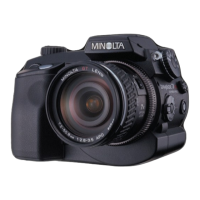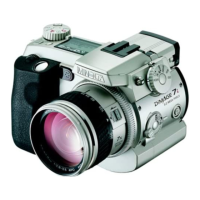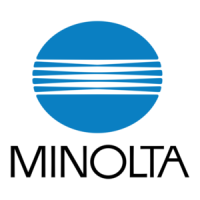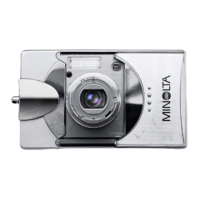140
141D
ATA-TRANSFER MODE
MEMORY CARD FOLDER ORGANIZATION
Once the camera is connected to the computer, image and audio
files can be accessed by double clicking on icons. Image folders
are located in the DCIM folder. To copying images and audio
recordings, simply drag and drop the file icon into a location in the
computer. Files and folders on the memory card can be deleted
using the computer. Changing file names
or adding other types of data to the card
with a computer may cause the camera to
malfunction. Never format the memory
card from the computer; always use the
camera to format the card.
Image and audio file names begin with “PICT” followed by a four-digit file number and a
tif, mrw, jpg, jpe, mov, or thm extension. Voice-memo files have a wav extension and
the file name corresponds to its image file. The thumbnail images (thm) are used in
camera and DiMAGE Viewer software operation.
When a new folder is created, the first three digits in the folder name will be one
greater than the largest folder number on the card. When the file number in the image
file name exceeds 9,999, a new folder will be created with a number one greater than
the greatest folder number on the memory card: e.g. from 100MLT10 to 101MLT10.
The file number on the image file may not correspond to its frame number on the
camera. As images are deleted in the camera, the frame counter will adjust itself to
show the number of images on the card and reassign the frame numbers accordingly.
The file numbers on the image files will not change when an image is deleted. When a
new image is recorded, it will be assigned a number one greater than the largest file
number in the folder. File numbers can be controlled with the file-number-memory
function in the advanced 1 section of the setup menu (p. 118).
Image files contain exif tag data. This data includes the time and date the image was recorded
as well as the camera settings used. This data can be viewed with the camera or the DiMAGE
Viewer software.
If a camera image is opened in a photo-retouching application that does not support Exif tags,
and then the image is saved overwriting the original data, the exif tag information is erased.
When using software other than the DiMAGE Viewer, always rename the image file to protect
the exif tag data.
Camera Notes
PICT0001.THM
Drive Icon
Dcim
PICT0001.TIF PICT0003.JPG
Extra fine, fine,
or standard
image
Misc
The misc. folder
contains DPOF
print files (p. 114).
PICT0004.JPE
Extra fine, fine, or
standard image
with an embedded
color profile.
100MLT10 10120801
Super-fine image
102MLTCP
From left to right: standard folder, date
folder (p. 122), and copy folder (p. 116).
PICT0002.THM
PICT0002.MRW
RAW image
PICT0004.THM
PICT0005.MOV
Movie clip
To view images correctly on your computer, the monitor’s color space may need to be adjust-
ed. Refer to your computer manual on how to calibrate the display to the following require-
ments: sRGB, with a color temperature of 6500K, and a gamma of 2.2.
Camera Notes
PICT0003.WAV
PICT0003’s
voice-memo file
PICT0004.THM

